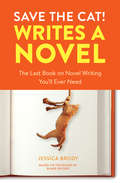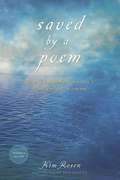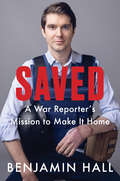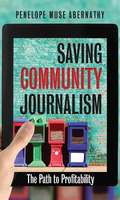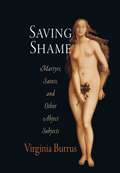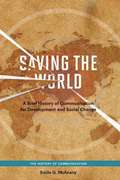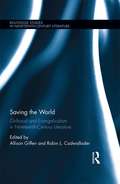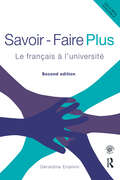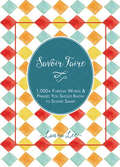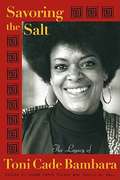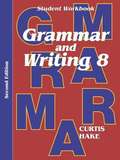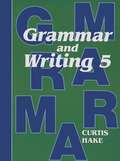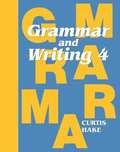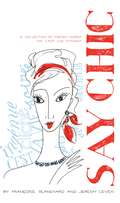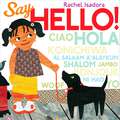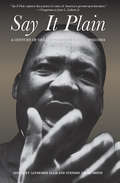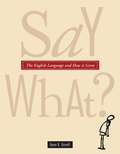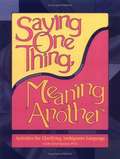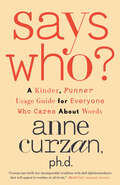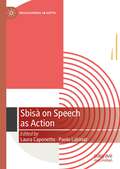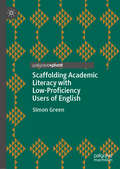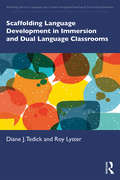- Table View
- List View
Save the Cat! Writes a Novel: The Last Book On Novel Writing You'll Ever Need (Save the Cat!)
by Jessica BrodyThe first novel-writing guide from the best-selling Save the Cat! story-structure series, which reveals the 15 essential plot points needed to make any novel a success.Novelist Jessica Brody presents a comprehensive story-structure guide for novelists that applies the famed Save the Cat! screenwriting methodology to the world of novel writing. Revealing the 15 "beats" (plot points) that comprise a successful story--from the opening image to the finale--this book lays out the Ten Story Genres (Monster in the House; Whydunit; Dude with a Problem) alongside quirky, original insights (Save the Cat; Shard of Glass) to help novelists craft a plot that will captivate--and a novel that will sell.
Save the Cat! Writes a Young Adult Novel: The Ultimate Guide to Writing a YA Bestseller (Save the Cat!)
by Jessica BrodyAn indispensable guide in the bestselling Save the Cat! story structure series that reveals the 15 essential plot points needed to make any young adult novel a success, from an accomplished novelist and the author of Save the Cat! Writes a Novel.In Save the Cat! Writes a Young Adult Novel, prolific author and story coach Jessica Brody presents a comprehensive story structure guide for anyone who wants to write a young adult novel by applying the famed Save the Cat! screenwriting methodology to the world of YA fiction. In this book, you will learn: • The fifteen &“beats&” (or plot points) that are necessary for crafting a successful story with a compelling character arc—including the Opening Image, Catalyst, Fun and Games, Bad Guys Close In, Dark Night of the Soul, and Finale• The ten universal story genres that will help you drill into what makes your type of story work, including those most commonly found in young adult novels like Rites of Passage, Superhero, Buddy Love, Institutionalized, and Golden Fleece• Quirky, original insights and writing tips like &“Save the Cat,&” the &“Shard of Glass,&” and the &“Dark Night Epiphany,&” that help you craft a story that will thrill and captivate teen readersFilled with practical advice, easy-to-follow templates, and &“beat sheets&” analyzing the structure of popular young adult novels such as Leigh Bardugo&’s Six of Crows, John Green&’s The Fault in Our Stars, and Lois Lowry&’s The Giver, this book is the ultimate reference for anyone who&’s ever dreamed of writing their own young adult bestseller.
Saved by a Poem: The Transformative Power of Words
by Kim RosenCan someone really be saved by a poem? In Kim Rosen's book, the answer is a resounding "Yes!" Poetry, the most ancient form of prayer, is a necessary medicine for our times: a companion through difficulty; a guide when we are lost; a salve when we are wounded; and a conduit to an inner source of joy, freedom, and insight. Whether you are a lover of poetry or have yet to discover its power, Rosen offers a new way to experience a poem. She encourages you to feel the poem as you might an affirmation or sacred text, which can align every level of your being. In an uncertain world, Saved by a Poem is an emphatic call to cultivate the ever-renewable resources of the heart. Through poetry, the unspeakable can be spoken, the unendurable endured, and the miraculous shared. Weaving teaching, story, verse, and memoir, Rosen guides you to find a poem that speaks to you so you can take it into your life and become a voice for its wisdom in the world. Inspirational CD Included! Featuring the voices of well-known authors reading a favorite poem and discussing its personal significance: Joan Borysenko, Andrew Harvey, Jane Hirshfield, Marie Howe, Grace Yi-Nan Howe, Robert Holden, Stanley Kunitz, Elizabeth Lesser, Thomas Moore, Christiane Northrup, Cheryl Richardson, Kim Rosen, and Geneen Roth.
Saved: A War Reporter's Mission to Make It Home
by Benjamin HallWhen veteran war reporter Benjamin Hall woke up in Kyiv on the morning of March 14, 2022, he had no idea that, within hours, Russian bombs would nearly end his life. As a journalist for Fox News, Hall had worked in dangerous war zones like Syria and Afghanistan, but with three young daughters at home, life on the edge was supposed to be a thing of the past. Yet when Russia viciously attacked Ukraine in February 2022, Hall quickly volunteered to go. A few weeks later, while on assignment, Hall and his crew were blown up in a Russian strike. With Hall himself gravely injured and stuck in Kyiv, it was unclear if he would make it out alive. <p><p>This is the story of how he survived—a story that continues to this day. For the first time, Hall shares his experience in full—from his ground-level view of the war to his dramatic rescue to his arduous, and ongoing, recovery. Going inside the events that have permanently transformed him, Hall recalls his time at the front lines of our world’s conflicts, exploring how his struggle to step away from war reporting led him back one perilous last time. Featuring nail-biting accounts from the many people across multiple countries who banded together to get him to safety, Hall offers a stunning look at complex teamwork and heartfelt perseverance that turned his life into a mission. <p><p>Through it all, Hall’s spirit has remained undaunted, buoyed by that remarkable corps of people from around the world whose collective determination ensured his survival. <p><p>Evocative, harrowing, and deeply moving, Saved is a powerful memoir of family and friends, of life and healing, and of how to respond when you are tested in ways you never thought possible.Benjamin Hall’s memoir includes a 16-page color photo insert. <p> <b>New York Times Bestseller</b>
Saving Community Journalism
by Penelope Muse AbernathyAmerica's community newspapers have entered an age of disruption. Towns and cities continue to need the journalism and advertising so essential to nurturing local identity and connection among citizens. But as the business of newspaper publishing collides with the digital revolution, and as technology redefines consumer habits and the very notion of community, how can newspapers survive and thrive? In Saving Community Journalism, veteran media executive Penelope Muse Abernathy draws on cutting-edge research and analysis to reveal pathways to transformation and long-term profitability. Offering practical guidance for editors and publishers, Abernathy shows how newspapers can build community online and identify new opportunities to generate revenue. Examining experiences at a wide variety of community papers--from a 7,000-circulation weekly in West Virginia to a 50,000-circulation daily in California and a 150,000-circulation Spanish-language weekly in the heart of Chicago--Saving Community Journalism is designed to help journalists and media-industry managers create and implement new strategies that will allow them to prosper in the twenty-first century. Abernathy's findings will interest everyone with a stake in the health and survival of local media.
Saving Shame
by Virginia BurrusVirginia Burrus explores one of the strongest and most disturbing aspects of the Christian tradition, its excessive preoccupation with shame. While Christianity has frequently been implicated in the conversion of ancient Mediterranean cultures from shame- to guilt-based, and thus in the emergence of the modern West's emphasis on guilt, Burrus seeks to recuperate the importance of shame for Christian culture. Focusing on late antiquity, she explores a range of fascinating phenomena, from the flamboyant performances of martyrs to the imagined abjection of Christ, from the self-humiliating disciplines of ascetics to the intimate disclosures of Augustine.Burrus argues that Christianity innovated less by replacing shame with guilt than by embracing shame. Indeed, the ancient Christians sacrificed honor but laid claim to their own shame with great energy, at once intensifying and transforming it. Public spectacles of martyrdom became the most visible means through which vulnerability to shame was converted into a defiant witness of identity; this was also where the sacrificial death of the self exemplified by Christ's crucifixion was most explicitly appropriated by his followers. Shame showed a more private face as well, as Burrus demonstrates. The ambivalent lure of fleshly corruptibility was explored in the theological imaginary of incarnational Christology. It was further embodied in the transgressive disciplines of saints who plumbed the depths of humiliation. Eventually, with the advent of literary and monastic confessional practices, the shame of sin's inexhaustibility made itself heard in the revelations of testimonial discourse.In conversation with an eclectic constellation of theorists, Burrus interweaves her historical argument with theological, psychological, and ethical reflections. She proposes, finally, that early Christian texts may have much to teach us about the secrets of shame that lie at the heart of our capacity for humility, courage, and transformative love.
Saving the World: A Brief History of Communication for Devleopment and Social Change
by Emile G. McananyThis far-reaching and long overdue chronicle of communication for development from a leading scholar in the field presents in-depth policy analyses to outline a vision for how communication technologies can impact social change and improve human lives. Drawing on the pioneering works of Daniel Lerner, Everett Rogers, and Wilbur Schramm as well as his own personal experiences in the field, Emile G. McAnany builds a new, historically cognizant paradigm for the future that supplements technology with social entrepreneurship. McAnany summarizes the history of the field of communication for development and social change from Truman's Marshall Plan for the Third World to the United Nations' Millennium Development Goals. Part history and part policy analysis, Saving the World argues that the communication field can renew its role in development by recognizing large aid-giving institutions have a difficult time promoting genuine transformation. McAnany suggests an agenda for improving and strengthening the work of academics, policy makers, development funders, and any others who use communication in all of its forms to foster social change.
Saving the World: Girlhood and Evangelicalism in Nineteenth-Century Literature (Routledge Studies in Nineteenth Century Literature #1)
by Allison Giffen Robin L. CadwalladerThis book makes a significant contribution to the burgeoning field of childhood studies in nineteenth-century literature and culture by drawing on the intersecting fields of girlhood, evangelicalism, and reform to investigate texts written in North America about girls, for girls, and by girls. Responding both to the intellectual excitement generated by the rise of girlhood studies, as well as to the call by recent scholars to recognize the significance of religion as a meaningful category in the study of nineteenth-century literature and culture, this collection locates evangelicalism at the center of its inquiry into girlhood. Contributors draw on a wide range of texts, including canonical literature by Harriet Beecher Stowe, Susan Warner, and Elizabeth Stuart Phelps, and overlooked archives such as US Methodist Sunday School fiction, children’s missionary periodicals, and the Christian Recorder, the flagship newspaper of the African Methodist Episcopal (AME) Church. These essays investigate representations of girlhood that engage, codify, and critique normative Protestant constructions of girlhood. Contributors examine girlhood in the context of reform, revealing the ways in which Protestantism at once constrained and enabled female agency. Drawing on a range of critical perspectives, including African American Studies, Disability Studies, Gender Studies, and Material Culture Studies, this volume enriches our understanding of nineteenth-century childhood by focusing on the particularities of girlhood, expanding it beyond that of the white able-bodied middle-class girl and attending to the intersectionality of identity and religion.
Savoir Faire Plus: Le Français à l’Université
by Géraldine EnjelvinWritten by an experienced tutor, Savoir-Faire Plus is specifically designed to meet the requirements of today’s generation of language undergraduates. Focusing on the life of an Anglophone first year undergraduate studying French in the UK and sharing a house with four francophone students, this engaging textbook provides: a clear, logical structure a blend of communicative, research-based and traditional exercises a wide range of activities covering the four key linguistic skills as well as intercultural skills authentic texts (with extracts from Le Monde, L’Express, Le Nouvel Observateur and Libération) guidance and practical tips for effective and independent learning. Each of the ten chapters consists of four topics-based sections which provide students with a wealth of diverse material allowing them to gain an in-depth knowledge of relevant topical subjects such as regional languages, sustainable development and fair trade, amongst others. Digestible grammar points are integrated throughout and a range of additional exercises are available on the Companion Website allowing students to perfect their language skills. Suitable for both self-study and class use Savoir Faire Plus is the ideal course for all advanced students of French, consolidating knowledge gained at A-Level while supporting the transition to undergraduate study. The Companion Website can be found at www.routledge.com/textbooks/9780415444750
Savoir Faire: 1,000+ Foreign Words & Phrases You Should Know to Sound Smart
by Laura LeeAn A-to-Z collection of foreign phrases to add to your lexicon—and information about the quirky, fascinating origins of the English language.Some foreign phrases are so good they become a sort of lingua franca. They capture the true zeitgeist, where the English translation is just comme ci, comme ca. If you’re a linguistics geek or language lover with a curiosity about the origins of foreign words and phrases, you need this beautifully designed reference that includes approximately 1,000 foreign phrases in languages that run the gamut from French to German to Japanese, Arabic, Sanskrit, and more. Entries offer precise translations, surprising origins, and commonly used terms you didn’t even know were foreign. (You may even find a phrase or two that you’ve been using incorrectly!) Also included are phonetic pronunciations and sidebars that explore the quirks of some favorite expressions.Don’t suffer one more trip to the museum asking yourself, “What the heck is trompe l’oeil?” Don’t put down yet another Umberto Eco novel out of sheer confusion. And avoid tumbling into the camp of declasse—instead, become one of the intelligentsia! This handy guide will make you a true cognoscente of culture.Praise for Laura Lee“Lee’s dry, humorous tone makes her a charming companion . . . She has a penchant for wordplay that is irresistible.” —San Francisco Chronicle
Savoring the Salt: The Legacy of Toni Cade Bambara
by Holmes Linda Janet Wall Cheryl A.In Savoring the Salt, a host of poets, scholars, writers, political activists and filmmakers recall Toni Cade Bambara, a woman whose voice and vision played a vital role in shaping African American culture in the last quarter of the twentieth century.
Saxon Grammar & Writing 8: Student Workbook (Second Edition) (Grammar & Writing Ser.)
by Steck-Vaughn Company WorkbookStudent Textbook: Each lesson contains instruction with examples, a set of practice questions, and a review set, which includes previous material, Weekly dictations for practice in spelling and punctuation, Suggested journal topics for student journals. Student Workbook: Writing lessons introduce students to key elements of writing, from combining sentences to constructing essays to writing short stories. Lessons include examples, practice questions, and review questions. Additional practice for grammar lessons: Fun Silly Story activities. Teacher Packet: Answers for all practice sets, review sets, and writing lessons, Schedule (144 school days), Test masters, Test answers.
Saxon Grammar and Writing Grade 5
by Steck-Vaughn Company Hake CurtisThe Student Textbook contains lessons that instruct students on eight key grammar and usage concepts: Capitalization, Punctuation, Sentence Structure, Parts of Speech, Usage, Spelling Rules, Diagramming.
Saxon Grammar and Writing: Grade 4
by Christie Curtis Mary HakeThis Grade 4 Saxon's Grammar Student Textbook contains 111 lessons and is written directly to the student. Developed to follow the classic Saxon model of incremental development and continuous review, lessons instruct students on a basic skill before moving on to examples, practice exercises, and review sets. Providing instruction on key grammar and usage concepts with bolded vocabulary and thorough examples, writing exercises are also included to help guide students through composing a complete essay. Journaling and dictation exercises help hone different writing skills. Topics covered in this Grade 4 text include types of sentences, capitalization, subject and predicate, the predicate nominative, indirect objects, phrases and clauses, proper adjectives, appositives, progressive verbs, antecedents, and more. 605 pages, indexed, softcover.
Say Chic
by Francoise Blanchard Jeremy LevenSAY CHIC...C'est magnifique! Ever wonder why some French words have become so common in English as to be clichés? Or why your witty repartee wouldn't be quite so witty without them? In Say Chic, Françoise Blanchard and Jeremy Leven collect more than seventy familiar French words and phrases that have become a permanent part of the American vocabulary. In their clever, often amusing style, the authors explain the origin of each word, its meaning, and how it came to be adopted into English. Uniting the sensibilities of an American author and a French author, these surprisingly entertaining stories combine world history, pop culture, etymology, and pithy observations about Americans and the French, with no small amount of panache. Featuring delightful illustrations, Say Chic will find its raison d'être on the bookshelf of anyone who has ever longed to be an American in Paris and hankers for a bit more of that irresistible je ne sais quoi in America.
Say Hello!
by Rachel IsadoraCarmelita loves to greet everyone in her colorful neighborhood. There are people from so many different cultures! They all like to say hello too, so now Carmelita can say hello in Spanish, English, French, Japanese, and many other languages. And her dog, Manny? Well, he seems to understand everyone, and gives a happy "Woof!" wherever he goes.Caldecott Honor winner Rachel Isadora's eyecatching collages are full of kid-friendly details like colorful storefronts, pigeons and an ice cream truck, making Carmelita's neighborhood fun to explore. Emphasizing the rich diversity of America's neighborhoods, this simple portrait of a child's day provides a great introduction to the joy of language.
Say It Plain: A Century of Great African American Speeches
by Booker T. Washington Jesse Jackson Clarence Thomas John Hope Franklin Julian Bond Martin Luther King Jr. Lani Guinier Howard Thurman Randall Robinson Stokely Carmichael Fannie Lou Hamer Joseph Lowery Dick Gregory Marcus Garvey Walter White Barbara Jordan Shirley Chisholm Thurgood Marshall Mary McLeod Bethune Charles Hamilton Houston Benjamin L. Hooks Louis Farrakhan Johnetta B. ColeA moving portrait of how black Americans have spoken out against injustice—with speeches by Thurgood Marshall, Shirley Chisholm, Jesse Jackson, and more. In &“full-throated public oratory, the kind that can stir the soul&”, this unique anthology collects the transcribed speeches of the twentieth century&’s leading African American cultural, literary, and political figures, many never before available in printed form (Minneapolis Star-Tribune). From an 1895 speech by Booker T. Washington to Julian Bond&’s sharp assessment of school segregation on the fiftieth anniversary of Brown v. Board in 2004, the collection captures a powerful tradition of oratory—by political activists, civil rights organizers, celebrities, and religious leaders—going back more than a century. Including the text of each speech with an introduction placing it in historical context, Say It Plain is a remarkable record—from the back-to-Africa movement to the civil rights era and the rise of black nationalism and beyond—conveying a struggle for freedom and a challenge to America to live up to its democratic principles. Includes speeches by: Mary McLeod BethuneJulian BondStokely CarmichaelShirley ChisholmLouis FarrakhanMarcus GarveyJesse JacksonMartin Luther King Jr.Thurgood MarshallBooker T. WashingtonWalter White
Say What I Am Called
by Dieter BitterliPerhaps the most enigmatic cultural artifacts that survive from the Anglo-Saxon period are the Old English riddle poems that were preserved in the tenth century Exeter Book manuscript. Clever, challenging, and notoriously obscure, the riddles have fascinated readers for centuries and provided crucial insight into the period. In Say What I Am Called, Dieter Bitterli takes a fresh look at the riddles by examining them in the context of earlier Anglo-Latin riddles. Bitterli argues that there is a vigorous common tradition between Anglo-Latin and Old English riddles and details how the contents of the Exeter Book emulate and reassess their Latin predecessors while also expanding their literary and formal conventions. The book also considers the ways in which convention and content relate to writing in a vernacular language. A rich and illuminating work that is as intriguing as the riddles themselves, Say What I Am Called is a rewarding study of some of the most interesting works from the Anglo-Saxon period.
Say What? The Weird and Mysterious Journey of the English Language
by Gena K. GorrellMore than a million words, weird spellings, words that are spelled the same but pronounced differently or vice versa. Where on Earth did the English language come from? The answer is that English isn't just the speech of one nation. It's the memory of thousands of years of history. It tracks the places people came from, the places they went, the adventures they had, the friends and enemies they made, the battles they won and lost. As English changed and grew, it became a jumble of sounds, words, and rules from countless languages and nations. And it's still changing and growing every day. More than seventy percent of all English words were born someplace other than England. That's why English can be so confusing and inconsistent. And that's why English is the richest, most international, and most versatile language in the world. This innovative book takes us on a journey through time to unravel and demystify the story of English. Word games, intriguing facts, and tricky quizzes add an element of fun while enriching readers' knowledge and understanding.
Saying One Thing, Meaning Another: Activities For Clarifying Ambiguous Language
by Cecile C. SpectorSaying One Thing, Meaning Another provides background information and materials necessary for educators to help individuals ages 10 through adult improve their understanding and use of ambiguous language. The activities use a cognitive approach to address deficits in the comprehension of multiple meaning words, idioms, irony, indirect and direct polite requests, and polite evasions. Use this book with individuals of normal development, those with language learning disorders, the hearing impaired, those with brain injury, as well as ESL students.
Says Who?: A Kinder, Funner Usage Guide for Everyone Who Cares About Words
by Anne CurzanA kinder, funner usage guide to the ever-changing English language and a useful tool for both the grammar stickler and the more colloquial user of English, from linguist and veteran professor Anne Curzan &“I was bowled over, page after page, by the author&’s fine ear for our language and her openhearted erudition. I learned a lot, and I couldn&’t have enjoyed myself more.&”—Benjamin Dreyer, New York Times bestselling author of Dreyer&’s EnglishOur use of language naturally evolves and is a living, breathing thing that reflects who we are. Says Who? offers clear, nuanced guidance that goes beyond &“right&” and &“wrong&” to empower us to make informed language choices. Never snooty or scoldy (yes, that&’s a &“real&” word!), this book explains where the grammar rules we learned in school actually come from and reveals the forces that drive dictionary editors to label certain words as slang or unacceptable.Linguist and veteran English professor Anne Curzan equips readers with the tools they need to adeptly manage (a split infinitive?! You betcha!) formal and informal writing and speaking. After all, we don&’t want to be caught wearing our linguistic pajamas to a job interview any more than we want to show up for a backyard barbecue in a verbal tux, asking, &“To whom shall I pass the ketchup?&” Curzan helps us use our new knowledge about the developing nature of language and grammar rules to become caretakers of language rather than gatekeepers of it. Applying entertaining examples from literature, newspapers, television, and more, Curzan welcomes usage novices and encourages the language police to lower their pens, showing us how we can care about language precision, clarity, and inclusion all at the same time.With lively humor and humanity, Says Who? is a pragmatic and accessible key that reveals how our choices about language usage can be a powerful force for equity and personal expression. For proud grammar sticklers and self-conscious writers alike, Curzan makes nerding out about language fun.
Sbisà on Speech as Action (Philosophers in Depth)
by Laura Caponetto Paolo LabinazThe volume provides a thorough look into Marina Sbisà’s distinctive, Austinian-inspired approach to speech acts. By gathering original essays from a world-class lineup of philosophers of language, linguists, social epistemologists, action theorists, and communication scholars, the collection provides the first comprehensive critical treatment of Sbisa’s outstanding contribution to speech act theory.
Scaffolding Academic Literacy with Low-Proficiency Users of English
by Simon GreenThis book analyses the development of academic literacy in low-proficiency users of English in the Middle East. It highlights the challenges faced by students entering undergraduate education in the region, and the strategies used by teachers to overcome them. The author focuses on a large-scale undergraduate teacher programme run in Oman by the University of Leeds, providing clear pointers both for future research and effective practice. He also explores the implications of his findings for countries beyond the Gulf Cooperation Council, demonstrating how international participation in UK HE could be much wider. This book will appeal to students and scholars with an interest in academic literacies and English for Academic Purposes.
Scaffolding Language
by Pauline GibbonsThe bestselling Scaffolding Language, Scaffolding Learning helped tens of thousands of mainstream elementary teachers ensure that their English language learners became full members of the school community with the language and content skills they needed for success. In the highly anticipated Second Edition, Pauline Gibbons updates her classic text with a multitude of practical ideas for the classroom, supported by the latest research in the field of ELL/ESL. With clear directions and classroom tested strategies for supporting students' academic progress, Gibbons shows how the teaching of language can be integrated seamlessly with the teaching of content, and how academic achievement can be boosted without sacrificing our own vision of education to the dictates of knee-jerk accountability. Rich examples of classroom discourse illustrate exactly how the scaffolding process works, while activities to facilitate conversation and higher-level thinking put the latest research on second language learning into action.
Scaffolding Language Development in Immersion and Dual Language Classrooms (Routledge Series in Language and Content Integrated Teaching & Plurilingual Education)
by Roy Lyster Diane J. TedickThis book introduces research-based pedagogical practices for supporting and enhancing language development and use in school-based immersion and dual language programs in which a second, foreign, heritage, or indigenous language is used as the medium of subject-matter instruction. Using counterbalanced instruction as the volume’s pedagogical framework, the authors map out the specific pedagogical skill set and knowledge base that teachers in immersion and dual language classrooms need so their students can engage with content taught through an additional language while continuing to improve their proficiency in that language. To illustrate key concepts and effective practices, the authors draw on classroom-based research and include teacher-created examples of classroom application. The following topics are covered in detail: defining characteristics of immersion and dual language programs and features of well-implemented programs strategies to promote language and content integration in curricular planning as well as classroom instruction and performance assessment an instructional model to counterbalance form-focused and content-based instruction scaffolding strategies that support students’ comprehension and production while ensuring continued language development an approach to creating cross-linguistic connections through biliteracy instruction a self-assessment tool for teachers to reflect on their pedagogical growth Also applicable to content and language integrated learning and other forms of content-based language teaching, this comprehensive volume includes graphics to facilitate navigation and provides Resources for Readers and Application Activities at the end of each chapter. The book will be a key resource for preservice and in-service teachers, administrators, and teacher educators.
